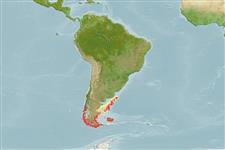Environment: milieu / climate zone / rango de profundidad / distribution range
Ecología
marino; salobre demersal. Temperate
Southeast Pacific and Southwest Atlantic: Chiloé Island south to Tierra del Fuego and the Falkland Islands.
Tamaño / Peso / Age
Madurez: Lm ? range ? - ? cm
Max length : 57.0 cm TL macho / no sexado; (Ref. 11954)
Short description
Claves de identificación | Morfología | Morfometría
Presence of pelvic fins which do not or just reach a vertical through the pectoral fin bases; present; origin of dorsal fin above base or anterior part of pectoral fin; without dermal appendages around mouth; gill opening extending downward to at least the middle of pectoral fin base, but not reaching the lower end of pectoral fin base; head depressed; body elongated and tail compressed, with depth about 7-9% TL (Ref. 37311).
Body shape (shape guide): eel-like.
Inhabits rocky intertidal zones and estuaries with suitable conditions (Ref. 11954). Found among macroalgae, below rocks and stones (Ref. 37311).
Life cycle and mating behavior
Madurez | Reproducción | Puesta | Huevos | Fecundidad | Larva
Anderson, M.E., 1994. Systematics and osteology of the Zoarcidae (Teleostei: Perciformes). Ichthyol. Bull. J.L.B. Smith Inst. Ichthyol. 60:120 p. (Ref. 11954)
IUCN Red List Status (Ref. 130435: Version 2025-1)
Threat to humans
Harmless
Human uses
Herramientas
Special reports
Download XML
Fuentes de Internet
Estimates based on models
Preferred temperature (Referencia
123201): 6.8 - 14.1, mean 10 °C (based on 136 cells).
Phylogenetic diversity index (Referencia
82804): PD
50 = 0.7500 [Uniqueness, from 0.5 = low to 2.0 = high].
Bayesian length-weight: a=0.00120 (0.00058 - 0.00248), b=3.10 (2.91 - 3.29), in cm total length, based on LWR estimates for this (Sub)family-body shape (Ref.
93245).
Nivel trófico (Referencia
69278): 3.5 ±0.4 se; based on size and trophs of closest relatives
Resiliencia (Referencia
120179): Muy bajo, población duplicada en un tiempo mínimo superior a 14 años (Preliminary K or Fecundity.).
Fishing Vulnerability (Ref.
59153): Moderate vulnerability (43 of 100).
🛈
